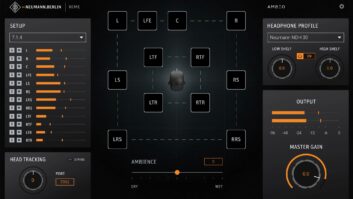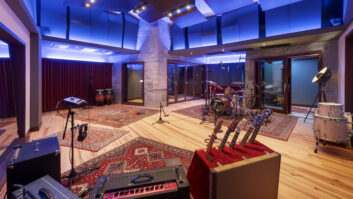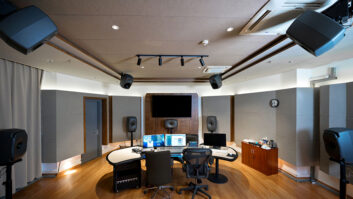In the world of studio design, form follows function, so it’s not surprising to learn that the hot-button topic in that universe currently is surround control rooms: With an increasing number of studios taking on surround work for audio, film and DVD, designers and acousticians have found themselves creating a new breed of control room, as well as retrofitting existing ones, to accommodate engineers’ up-to-the-minute needs.
Recently, we spoke to a handful of top designers to find out how they’re meeting the surround challenge: Carl Yanchar of Wave:Space, John Storyk of the Walters-Storyk Design Group (WSDG), Francis Manzella of FM Design and Martin Pilchner of Pilchner Schoustal International.
5.1…SON OF QUAD!
It was, to quote that esteemed guru, Yogi Berra, “deja-vu all over again” when Carl Yanchar and Wave:Space were brought in to do a complete overhaul of Glenwood Place Studios in Burbank, Calif. Yanchar was involved in the original studio’s design on that site 30 years ago. Back then, it was Kendun Recorders, which enjoyed a long run as a top Southland facility; more recently, it was known as Front Page. And when it came time to rework the control room for Glenwood Place’s so-called “Stealth” surround mixing studio, which is based around a Euphonix System 5, Yanchar already had a leg up, because that room was originally designed as a Quad mastering room back in the day.
“It was a completely symmetrical room, like two really good stereo rooms back to back,” Yanchar says. “It was also the first Hidley room that had 360-degree trapping around it. Still, even though it was an existing room, we effectively tore it down to the shell — it’s 26 feet by 26 feet — and rebuilt it, primarily because the ceiling of the original room, which had been modified over the years but had one of the old-type compression ceilings, had to go. Now it has what you might call an expansion ceiling, because the angle tilts upward from the monitors, which changes the reflections from the low frequencies and, depending on the geometry, some of the midrange, as well.” There have also been major aesthetic changes, stripping away the dark-walnut hardwood and replacing it with maple and lighter fabrics throughout.
The room was designed with surround music mixing in mind, rather than audio post, and Yanchar notes, “That’s one of the decisions the client has to make: What their primary market is. For music, the preference is to have the five primary speakers equidistant from the mixer, like it was in Quad. In fact, some people don’t really use the center speaker, so it’s very much like Quad. Whereas in film and TV, there is the so-called ITU standard, where the surround speakers are basically 110 degrees, so they’re closer to the side of you than behind you, which, obviously, doesn’t work too well for music.
“Because of the different standards, it’s difficult to build something that’s truly multipurpose without compromising one or the other. Often, they don’t use the same type of speakers, because you probably want to use matched full-range speakers for music; and in film and TV, the surrounds are sometimes just smaller subsets of the same series. Sometimes not even that. There are even some places that are putting in multiple surround speakers so they can switch back and forth to accommodate both situations.”
At press time, Glenwood Place had a second 5.1 mix room about to go online, this one based around an SSL 9000 K. “That was also a Quad room originally, and also a square exterior shell,” Yanchar says, “so we didn’t have to do anything radical to the shape of the room or anything. We just added the center speaker and the subwoofers…well, actually, it required a bit more than that, but it definitely made the job easier because it had already been a surround room before.”
BIGGER IS BETTER
“We’ve done stereo rooms that are converted to 5.1, and built surround rooms from the ground up,” says John Storyk. “Designing a 5.1 environment from scratch is a lot easier. You get to not make certain mistakes. You’re more in control of surface reflections, particularly with respect to the rear surround speakers.
“In general, it’s easier to get a 5.1 environment to work in a larger room, or in a room where you’re more in control of the geometry. WNET [in Manhattan], for instance, is not a particularly big room, but because we were able to orient the room sideways and have the sidewall boundaries splayed in excess of 20 degrees of center, we did not run into harsh first-order reflections from these surfaces, even though they are glass. Although most post-production rooms have little or no glass, this is not the case at WNET. 5.1 environments that are also used as tracking rooms, thus often requiring a great deal of glass in the front of the room, pose the most difficult challenges. Mid-high-frequency ray reflection software can assist in predicting exact boundary angles.
“But, again, bigger is going to help you. It’s also going to help you with low frequencies, because your first-order standing wave is going to be lower because the longest dimension is bigger. This is the easiest argument for a bigger room. But it’s expensive; it costs money to build, you need bigger speakers, etc.”
When converting a stereo control room to a 5.1-ready environment, Storyk says, “The first thing we have to do is check the location of the surround speakers. Typically, the stereo rooms will be set up with left and right at about 30 degrees off-axis, so chances are, we’re not going to have any problem with them. The center channel is in the center, obviously. There, the only issue might be the exact placement of the speaker vs. a video monitor or screen of some sort. Is the center channel fighting for the same space as the plasma screen or video monitor? The best solution is a projector with an acoustically transparent screen; however, cost, size and noise sometimes prohibit this solution. At Lower East Side, for instance, we had a screen with a projector. At Carter Burwell’s studio, we put the audio monitor in the prime center location and just put the plasma screen up a little bit; his thinking was, ‘Hey, I’m most concerned with the audio mix, not the video image.’ If you look at the ITU specs, they permit the rear surround to come up just a little bit. That helps if you have a plasma or big TV in the front, because now everything is being aimed down. Although at Mi Casa [Bob Margouleff’s mastering facility in Los Angeles, designed by WSDG], Bob was very strict about having the monitors all at the same ear level. There are arguments pro and con. They can get away with it because they have a very, very big room. As your room gets smaller, and you start getting more machines and more reflections and more glass, it gets a bit more difficult to accomplish.”
The WNET project posed another interesting problem to Storyk “because the only place for the rear speakers was the exact same space as the keyboard location in the production area desk. So what we did was have the speakers come up on motors. When they want to work in 5.1, they come right out of the rear desk; it’s the first time we’ve done that, but it was the only way to solve the problem. The speakers wanted to be where something else needed to be. So how do you do two things at the same time?” Problem solved.
SWEET SPOT(S)
“I think by now most people have figured this out,” says Francis Manzella, “but four or five years ago, when the whole 5.1 thing was just starting, something that people hadn’t really become attuned to is that when you’re setting up surround monitors, the most important part of the equation, other than having five speakers that are basically the same, is having five speakers that are the same distance from you. What people very commonly do is put three speakers across the front, and so they end up with a center speaker that is significantly closer to them than the left and right speakers. What this does is shorten the path length, and everything you put out of the center speaker seems forward of everything else; it seems to be standing apart from the rest of the mix in a more present way. Well, guess what? It’s arriving at your head anywhere from a millisecond to two milliseconds earlier than everything else, and that’s going to make it more prominent. As a result of this, some people were shying away from the center speaker.”
Manzella adds that the best way to configure for the speakers is to think of the listening area as a circle, and each speaker is located equidistant at a point on that circle. The infamous sweet spot, then, is in the middle of that circle. Creating the perfect circle, though, depends on more than mere whim; before you even worry about reflections, there is room geometry to think about, and such other concerns as the size of the console in the room.
“You’d always define a sweet spot in a stereo room somewhat based on the size of a console,” Manzella says. “If you’re going to have to slide 10 feet across the console to make adjustments and you’re listening on giant monitors, we would opt for a larger stereo triangle that focuses slightly farther behind the console than if you had a Mackie 8-bus and a couple of Genelecs. One of the things with 5.1 is there really only is one sweet spot — I think there is only one seat where you can make critical decisions about balance and timbral decisions when it comes to 5.1. That said, I also believe — trying to remove my critical hat for a moment, and a lot of my clients have pointed this out to me, as well — that even if you’re sitting behind the surround speaker in a good-sized room, you can still perceive that there are multiple sources, and I think there is some experience to be had beyond the sweet spot. Just as in stereo, if you’re not sitting pretty close to the middle — if you’re standing off to the side of the room — you’re going to miss a lot of the subtle depth of imaging and the subtle panning, but that doesn’t mean that you can’t still tell that there are two speakers and there is program spread across those two speakers.
“As far as designing 5.1 rooms, it’s like taking the stereo rooms and raising it by a factor, because now instead of two sources to be concerned about reflections from, there are five. Most of our clients are still doing primarily stereo work. Most are doing a little surround and want to be prepared for a larger amount of surround.
“Obviously, it’s going to be different designing a room just for mixing and designing a 5.1 room attached to a recording room. The real world of music recording studios is if you’ve got a room for musicians, you’re going to have glass. There’s a whole psychology about glass: What we try to do with our designs is eliminate as much of the barrier as possible between the control room and the musicians by extending the size of the window beyond what may be necessary for visual contact, to make the musicians feel like they are not being looked at through a porthole; not feel so separated from what’s going on in the control room. The more you make it feel like one big working environment, the more comfortable everyone is going to be. So we’re always trying to break down the psychological boundary between the control [room] and the live room.
“But, of course, glass is very reflective, and when you’ve got surround speakers projecting forward, that can be a problem. We do everything we can to position surround speakers and control the size and angle of the glass in the front portion of the room to minimize early reflections from the surround speakers. It can be difficult. I’m not aware of any solutions that work for all situations. We have the same problem with near-field speakers that are not in the wall, because then you have sound diffracting around the back of these speakers and splashing off the glass. I haven’t been able to angle the glass to make them completely go away. So it’s all a matter of degree and cautious compromise.
“One of the things we’ve been experimenting with in freestanding speaker environments is actually making a version of a diffuse return system for the front of the room, the way we do in the back of the room, so that the surrounds are not just orphan children sitting on the sidewall. Over at Sterling Sound, all the front parts of the rooms were considered as carefully as the rear parts when it comes to steering reflected sounds into diffuse devices. The diffusers are not visible — they’re hidden behind fabric — and the sound gets to them in a different way than the sound gets to the rear diffusers from the main front speakers. We have side walls and doors feeding the rear diffusers, but in the front, we have reflections off the floor and the angled glass in the front of the room that steer sound from the surrounds into the diffusers. We didn’t have that luxury at Egan Media, because the front of the room is full of equipment, monitors and glass. But we did play the angles of the glass carefully to avoid as much as possible early reflections from the surround speakers.
“Another interesting thing about Egan [Media] is that we have a much higher ceiling in the front half of the room than we do in the back. That was dictated by the building, but we designed into that and made it a feature, if you will, so the rear part of the room is damped down. We still have diffusers and trapping going on in the back half of the room, but the ceiling is much lower and the lighting is different. Technically, you’re out of the listening area, but it still sounds nice and pleasant back there, at least in stereo.”
Like a lot of designers these days, Manzella’s company now builds its own custom monitor systems — The Griffin loudspeakers — specially tied into the control room design, “but a lot of my clients still have a strong predetermination about their equipment,” he says.
Manzella notes that 5.1 has been good for the business and good for recording, but he wonders aloud about the ultimate fate of all these high-end, technically brilliant recordings: “How many people on the other end have a system that’s even close to being properly set up? How many people even have a stereo system that’s close to being a reasonably proper setup: an equidistant triangle, similar reflections on one side or the other. Let’s face it,” he says with a laugh, “all this work we do in these fantastic rooms ends up getting played in out-of-control rooms. We’re doing production; the reproduction is not up to us. We have to maintain as high a standard as we can. Unfortunately, you can’t have one of us go around to every living room and see that it’s set up properly.” Not a bad idea, though.
SURROUNDING ANGEL MOUNTAIN
One doesn’t normally think of Bethlehem, Penn., as a major music or film production center — it’s a steel town, right? But it’s also just an hour from Manhattan and close to Philadelphia, as well, and now it is poised to become a major player in the recording and post-production industries. Angel Mountain is the name of a new multistudio complex being built from the ground up in Bethlehem, and it is certain to cause a few ripples in the already-competitive Northeast corridor when it opens officially near the end of the summer.
Design for the modern, minimalist structure was by Toronto-based Pilchner Schoustal International, and it incorporates four surround rooms and several writing rooms. “It’s a multi-use facility,” comments Martin Pilchner, “for music recording and for film and television post work, so there are a number of different options available for different kinds of work.” “The grand room,” as Pilchner calls it, is a surround mix room based around an SSL 9000, which he describes as “the first big analog console that really solves surround panning issues.” Another smaller room features a Euphonix System 5. Both of those are adjacent to a recording room large enough to accommodate a full orchestra — for film scoring, of course. A third room is a Pro Tools suite, and then there are also writing rooms. In addition to these 5.1 suites, there will be a full THX-certified mix theater. Quested monitors, which, along with Genelecs, have long been a preference of Pilchner Schoustal, are prominent in the Angel Mountain plans.
Echoing the concerns of the other designers in this article, Pilchner says that film mix rooms and 5.1 music rooms have unique characteristics that must be dealt with sonically. “For 5.1, the ITU recommendation is that you have five monitors equidistant from the listening position; left and right are 30 degrees off the center, and the rears are 110 degrees off the center. For a film mix theater, it gets set up like a conventional cinema space where you have the three to five speakers for everything behind the screen and then smaller, distributed surround speakers. For music, there is a sweet spot that you’re mixing to, but in the cinema, you’re really trying to provide uniform coverage for wall-to-wall people inside the listening area, so it requires a different approach to speaker placement and room treatment. In post rooms, you’ve always got a conflict of either where the picture or where the glass should be.
“Also, in a film-style mix room, where you have three speakers lined up flat across behind the screen, you have to think about the screen interaction, which influences the sound a little bit. There is cancellation that occurs between the screen and the speaker based upon the distance between them. If the center speaker is pushed back to align the time domain, this cancellation changes frequency, which, even on a good screen, is audible on an A/B. So what we end up doing is keeping the speakers in the same relationship with the screen distance and applying a slight digital delay for the time domain — like a 1-millisecond delay — pushing that center speaker back, and it satisfies both conditions. This was carried out with great success in a film mix suite at Deschamps Studios in Toronto.
“The better control rooms have some depth. If you’ve got a small room and you’re cutting corners, then you can’t put the rears where they need to be, and then you end up having to use delays, which is not the end of the world but isn’t ideal, certainly. If all the conditions are right, you should be able to close your eyes and pan a source through all the channels and not have it change tone, only position. An imbalance in room treatment, speaker coupling or speaker loading will work against you in this regard.
“Another important factor in room design is providing enough LF damping. This was always an issue in stereo control rooms, but now is compounded by firing five mains and a subwoofer. To properly monitor the low end, there has to be enough treatment to keep it in context with the rest of the system. Cinemas have been dealing with this problem for years.”
Pilchner Schoustal has extensive experience designing surround environments — another recent project was the overhaul of two control rooms at Phase One in Toronto — but Angel Mountain clearly represents the high end of the technological spectrum. “It’s going to be quite a facility,” Pilchner says with characteristic understatement. “They want to make it truly state-of-the-art. They should be very competitive.”







